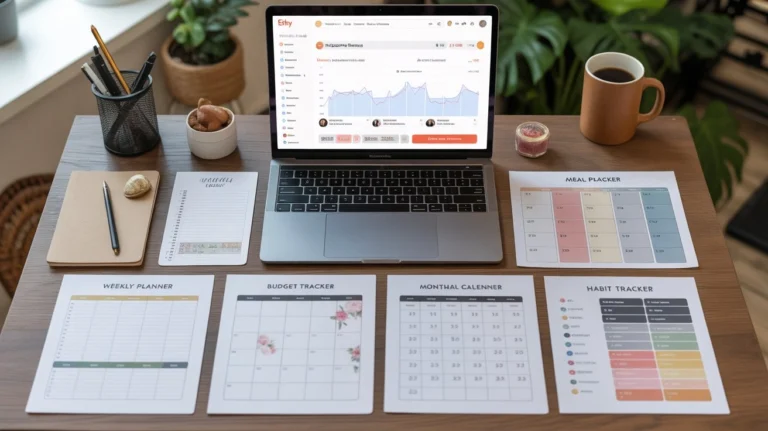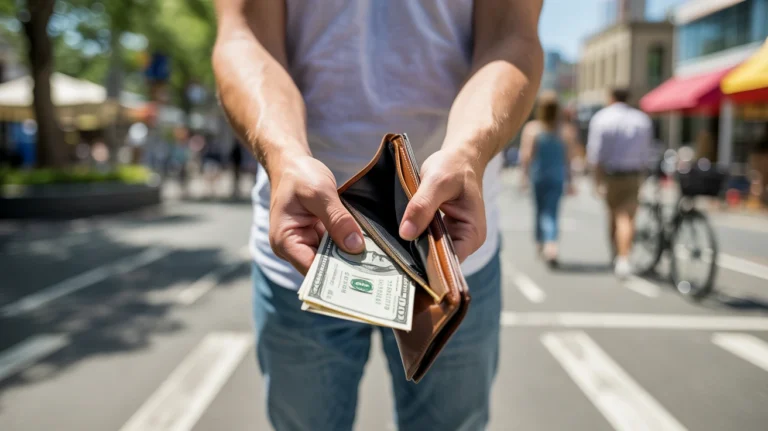Savings Challenge: Save $1,000 in 30 Days (Step-by-Step Guide)

Saving money is hard when life keeps throwing bills and surprises at you. You plan to save, but somehow the money disappears. Sound familiar?
That’s why a 30-day savings challenge works so well. It’s short, simple, and has one goal: save $1,000 in a month. With a clear plan, you’ll know what to do each day — cut a little spending here, save a little extra there — until the total adds up.
By the end, you’ll have more than just money in your account. You’ll also have proof that you can control your cash and build good habits that last.
Why Do a 30-Day Savings Challenge?

Saving money is one of those goals everyone talks about but struggles to stick to. A $1,000 cushion can feel out of reach when bills, groceries, and everyday expenses eat up most of your paycheck. That’s where a 30-day savings challenge comes in. Instead of waiting months or even years to build a solid fund, you set a short, focused timeframe and a specific number to hit. The urgency makes it more exciting, and the deadline keeps you accountable.
There’s also a psychological win here. Research shows that shorter challenges are easier to commit to because the finish line feels visible. You’re not telling yourself “I have to save forever,” you’re saying “I’ll push hard for 30 days.” This small shift is often what sparks lasting financial habits. Think of it as a reset button for your spending: in just one month, you can prove to yourself that saving big is possible, even if your income feels tight.
The Psychology of Short-Term Goals
Long-term goals like retirement or paying off a mortgage are important, but they can also feel overwhelming. A short-term challenge works differently. It gives you instant feedback: every day, every week, you see your progress stack up. This momentum builds confidence and makes it easier to stick with bigger goals later. For many people, a $1,000 fund is the first step toward building an emergency cushion that keeps them from sliding back into debt when life surprises them.
Crisis Cushion vs. Long-Term Habit Building
Why $1,000 specifically? Because that amount is big enough to cover most small emergencies — a car repair, a dental bill, or a last-minute flight — without wiping you out. At the same time, it’s not so large that it feels impossible to reach in a month. Think of this challenge as building a crisis cushion: it protects you from relying on credit cards, payday loans, or borrowing from friends. Once you complete the challenge, you can repeat it or shift into longer-term saving for bigger goals like vacations, debt payoff, or retirement. The 30-day sprint is the jumpstart; the habit you form during it is the real prize.
How the 30-Day $1,000 Savings Challenge Works
A savings challenge works because it gives you rules and structure. Instead of just hoping to save, you commit to a set plan for 30 days. The number feels big — $1,000 — but when you break it down, it becomes more realistic. Here’s how to make it work for you.
Step 1: Set Your Goal and Timeline
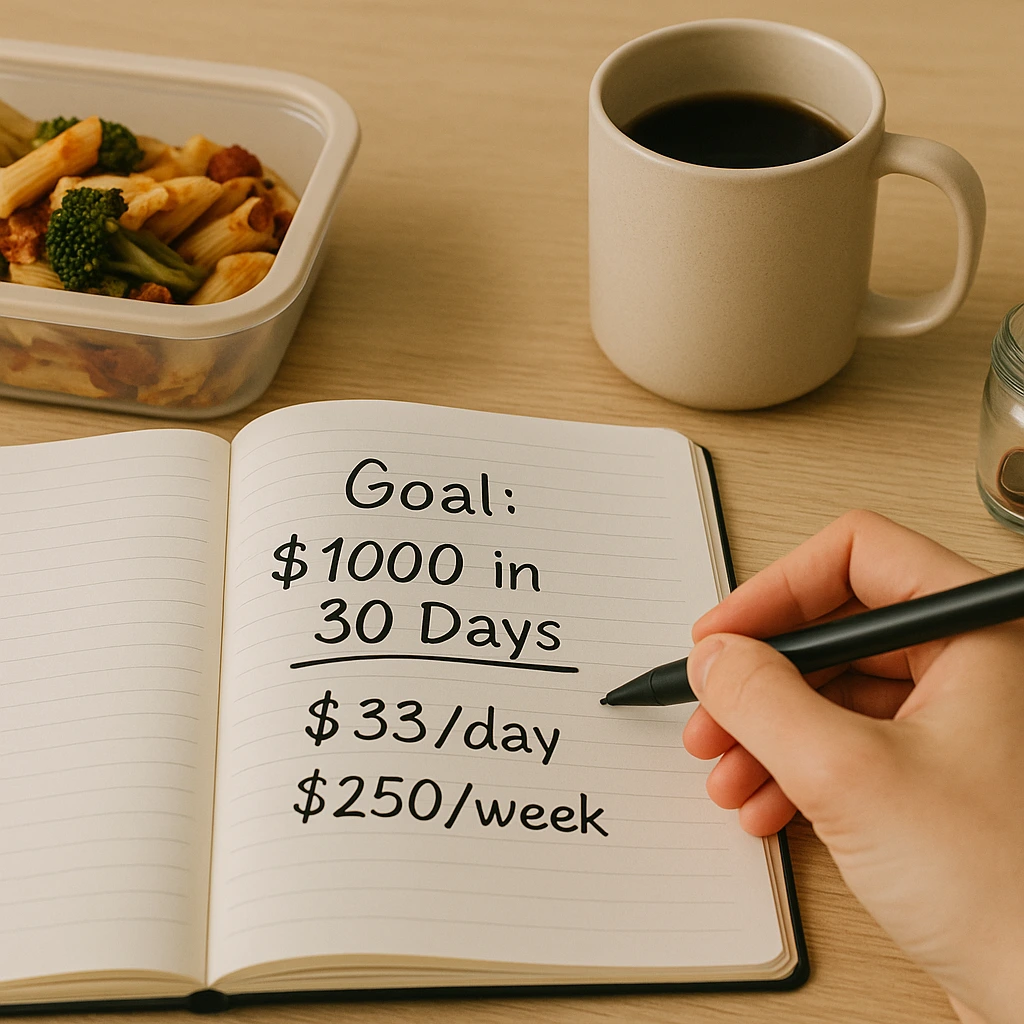
The goal is simple: save $1,000 in 30 days. If you break it down, that’s:
- About $33 a day, or
- About $250 a week.
Breaking it into smaller chunks makes it feel less scary. Instead of thinking, “How do I come up with a thousand dollars?” you just focus on today’s number. For example, bringing lunch from home instead of buying it could save you $12. Making coffee at home instead of stopping at a café saves another $5. That’s already more than half your daily goal covered.
The timeline also matters. Thirty days is short enough that you can push yourself without burning out, but long enough to build a habit. Think of it as a sprint — you’re focused for one month, then you can slow down or keep going if you like the results.
Step 2: Choose a Method That Fits You
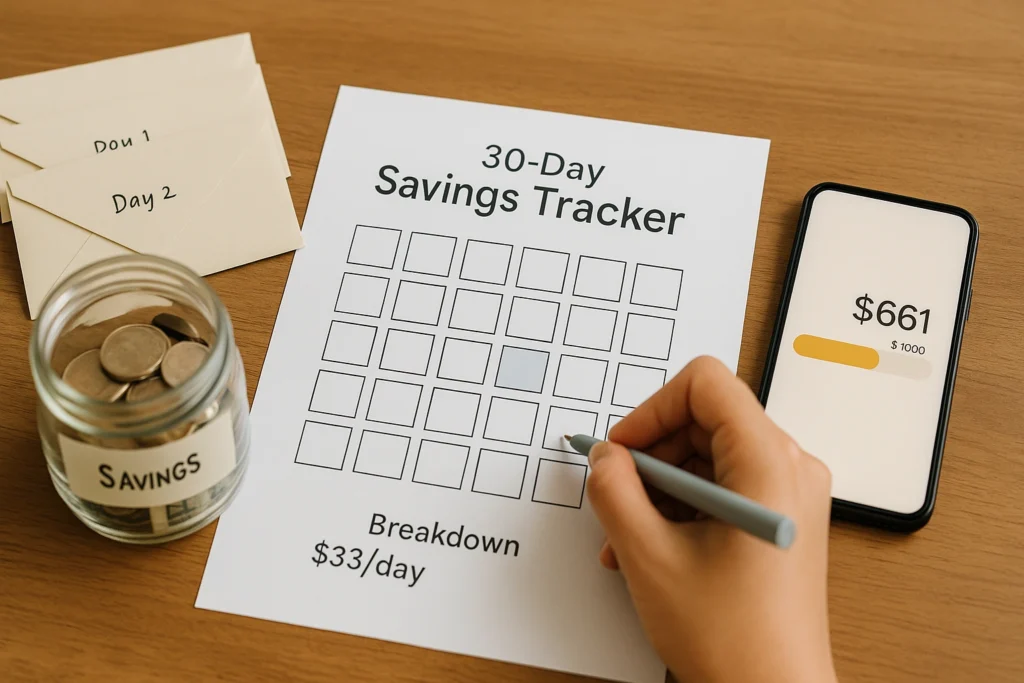
Not everyone saves the same way. Pick a method that matches your personality and lifestyle:
- Daily method: Set aside $33 each day. You can transfer it to savings or put it in a cash envelope. This works if you like small, steady steps.
- Weekly method: Save $250 once a week, like on payday. This is easier if you get paid weekly or biweekly and like bigger, fewer moves.
- Flexible method: Some days you save $50, some days $20, depending on what you can afford. As long as you hit $1,000 by day 30, you’re winning.
💡 Tip: If your income is irregular (like freelancing or gig work), the flexible method works best. Save more on high-income days so you’re not stressed on leaner days.
Step 3: Use Tools to Track Your Progress
Tracking makes the challenge more real — and more fun. When you see progress, you stay motivated. Try one of these:
- Printable trackers: Draw 30 boxes on paper and colour one in each day you save. By the end, you’ll have a full page showing your hard work.
- Apps: Free apps like YNAB or Good budget let you see your savings grow in real time. You can even set alerts so you don’t forget.
- Envelope system: Label 30 envelopes with Day 1 to Day 30. Each day, put in the amount you’re saving. Seeing the envelopes fill up is surprisingly satisfying.
📊 Example: If you choose the daily method, you’ll end up with 30 envelopes and $1,000 by the end of the month. If you use an app, you can watch your balance climb every time you make a transfer. Both methods give you the same result — but one might feel more exciting depending on your style.
Step 4: Build Accountability
One big reason people quit savings challenges is because no one knows they started. Tell a friend or family member you’re doing this. Even better, invite them to join you. Having someone to check in with makes it harder to quit and adds some healthy competition.
Step 5: Decide What to Do With the $1,000
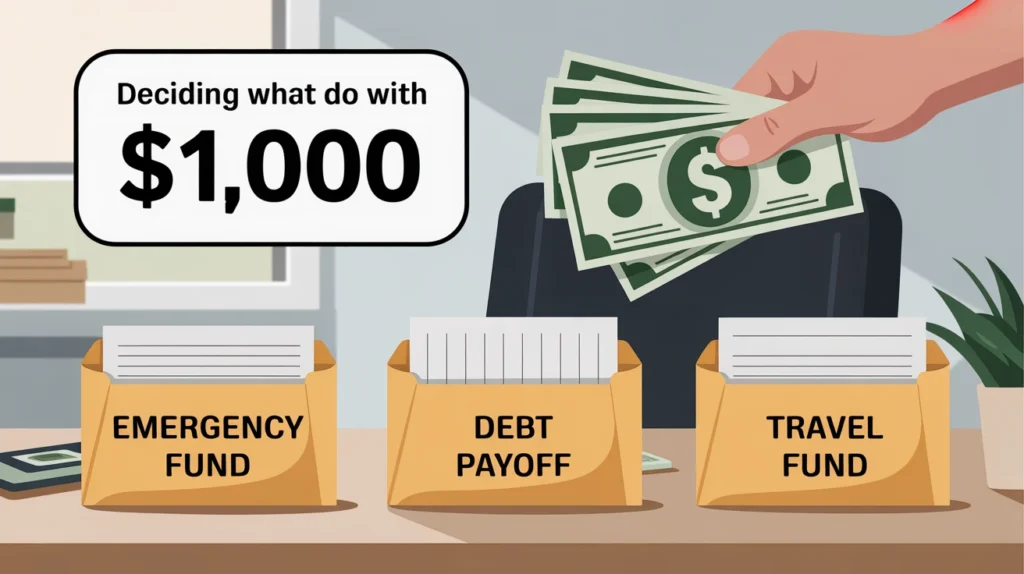
Before you even start, know what your money is for. This helps you stay motivated. Here are a few smart options:
- Emergency fund → First priority for most people. A $1,000 cushion protects you from credit card debt when life throws surprises.
- Debt payoff → If you already have an emergency fund, use the $1,000 to wipe out high-interest debt.
- Big goal fund → Maybe you’re saving for travel, a new laptop, or moving costs. Assigning a purpose makes the money more exciting to save.
7 Daily Habits to Maximize Savings

If you want to save $1,000 in 30 days, it’s not just about cutting random things. It’s about creating small daily habits that stack up quickly. These are changes anyone can try, and each one puts real dollars back into your pocket.
1) Make Your Own Coffee and Lunch
Buying coffee and lunch every day feels small, but it adds up fast. A $5 coffee and a $12 lunch is $17 a day — more than half your daily savings goal. Over a month, that’s more than $500.
Instead, brew your own coffee at home and pack simple lunches like sandwiches, wraps, or leftovers. Not only does this save money, but it also helps you eat healthier. You don’t need to do it perfectly every day — even swapping three café visits a week for homemade drinks gets you closer to $1,000.
2) Pause Wants for 72 Hours
Impulse buying is one of the biggest budget leaks. You see something online, hit “buy now,” and regret it later. A simple fix is the 72-hour rule: wait three days before buying anything that’s not essential.
Most of the time, the urge fades, and you save yourself money. If after three days you still want it and it fits your budget, go ahead. But you’ll be surprised how many “must-haves” turn into “I don’t really need it.” This one habit alone can save hundreds.
3) Try the Savings Bingo or Colour Chart Method
Saving can feel boring, so turn it into a game. With savings bingo, you write different amounts (like $10, $20, $50) in a bingo-style chart. Each day, pick one to save and mark it off. With a colour chart, you fill in a square every time you hit a savings goal.
The fun part? You see your progress grow day by day. These methods work especially well if you’re visual or like challenges. Families can also do it together, letting kids color in the chart when you save. It makes the process more exciting and helps you stay motivated for the full 30 days.
4) Round Up Spare Change Automatically
Many banks and apps now let you round up your purchases to the nearest dollar and put the difference into savings. Buy something for $4.30, and $0.70 goes straight into your savings account. It feels painless because you don’t notice it day to day.
In a month, these small amounts can add up to $50 or more — without you lifting a finger. If your bank doesn’t offer it, try apps like Acorns or Chime. Pair this with the other habits, and you’ll reach $1,000 much faster.
5) Plan No-Spend Weekends
Weekends are when people tend to spend the most — movies, dinners out, shopping trips. For this challenge, commit to no-spend weekends where you only cover basics like food and gas.
Instead of spending, plan free or low-cost activities: explore a park, cook at home, visit the library, or have a game night with friends. Cutting even two weekends of spending can save $200–$300, which is a big chunk of your goal.
6) Review and Cancel Subscriptions
It’s easy to forget about subscriptions — streaming services, apps, beauty boxes, and memberships you barely use. Go through your bank statement and list every recurring charge. Cancel the ones you don’t really need for this month.
Even pausing one or two services can save $20–$50 right away. Over 30 days, that money makes a noticeable difference. You can always restart later, but during the challenge, think of it as “borrowing” money back from wasted spending.
7) Meal-Plan with Pantry First
Food is one of the biggest costs in any budget. The trick isn’t just buying less — it’s using what you already have. Before going to the store, check your pantry and freezer. Plan meals around those items first.
For example, if you already have rice, pasta, or beans, build meals around them and just buy the extras you need. This prevents waste and lowers your grocery bill. Families that meal-plan this way often save $50–$100 a week — that’s $200–$400 in just one month.
10 Fast Actions That Free Up Cash Fast
Along with daily habits, you can make bigger moves that free up money right away. These are one-time actions that put cash back in your pocket quickly. Do a few of these during your 30-day challenge, and you’ll hit $1,000 even faster.
1) Negotiate Your Bills
Call your cell phone, internet, or insurance company and ask for a better deal. Many providers have hidden discounts or cheaper plans if you ask. Even a $20 cut in your monthly bill means $240 saved in a year. During a savings challenge, every dollar counts.
If you’re nervous about calling, try this script: “Hi, I’ve been a loyal customer, but I need to lower my bill. Are there any discounts or promotions I qualify for?” You’ll be surprised how often they say yes.
2) Sell Unused Items Online
Look around your home. Old clothes, electronics, small furniture, or even books can be turned into cash. Apps like Facebook Marketplace, eBay, or Poshmark make it easy.
Set a goal to list five items this week. Even if you only sell three things at $50 each, that’s $150 toward your savings goal. Plus, decluttering makes your home feel lighter and more organized.
3) Use Cash-Back Apps
Cash-back apps and browser extensions (like Rakuten or Honey) give you money back when you shop. While you shouldn’t spend more just for rewards, using these apps for planned purchases helps.
For example, buying groceries or household items through a cash-back app might return $20–$30 in a month. Transfer this “bonus” directly into your savings challenge fund.
4) Slash Your Grocery Bill
Food is one of the easiest areas to save. Buy generic brands instead of name brands, use coupons, and shop sales. Cooking from scratch instead of buying pre-made meals also cuts costs.
If your grocery bill is usually $500 a month, small changes can lower it to $400. That $100 difference is already 10% of your challenge goal.
5) Skip the Car Wash and DIY Cleaning
A car wash might cost $15–$20 each time. Instead, wash your car at home with a bucket, soap, and water. For house cleaning, make your own solutions with vinegar and baking soda instead of pricey cleaners.
Not only do you save money, but DIY options are often healthier and more eco-friendly.
6) Pause Salon and Beauty Services
Hair coloring, manicures, and spa visits can be expensive. For one month, try doing them at home or skipping them altogether. If you usually spend $60–$100 a month on these services, you’ll save instantly by waiting until after the challenge.
Think of it as a temporary pause, not forever. After the 30 days, you can choose which services you really miss and which you don’t need as often.
7) Declutter with a Daily Box Rule
Grab a box each day and fill it with items you don’t use. By the end of the week, you’ll have things to sell, donate, or recycle. Selling even a few items makes quick cash, and donating others can sometimes bring a tax deduction.
The daily box rule also helps you see how much “extra” stuff you’ve been buying. It’s a great reminder to be more mindful with future purchases.
8) Swap Ride-Shares for Public Transit or Biking
Taking Uber or Lyft a few times a week adds up quickly. If one ride costs $15, that’s $60 a week. Switch to public transit or biking whenever possible.
Even replacing two rides per week with cheaper options can save $120 in 30 days. That’s more than 10% of your $1,000 goal.
9) Use Cash Envelopes for Spending
Pick three categories where you tend to overspend — like dining out, entertainment, or shopping. Put the budgeted amount of cash in an envelope for each category. When the envelope is empty, you stop spending.
This method keeps you from swiping your card without thinking. For many people, it cuts $50–$200 of wasteful spending in just one month.
10) Prep Freezer Meals After Payday
Right after you get paid, cook a few meals in bulk and freeze them. Having food ready stops you from ordering takeout on busy nights.
Even if this saves you from ordering pizza twice a week, that’s $25–$30 saved each time. Over four weeks, that’s $100–$120 toward your savings challenge.
What to Do When You Don’t Hit $1,000?
Not everyone will reach the full $1,000 in 30 days, and that’s completely normal. Life happens — maybe an unexpected bill came up, or your income was lower this month. The key is to see the challenge as progress, not failure. Even if you only saved $500, that’s still $500 more than you had before.
Adjust the Goal, Not the Habit
If you can’t reach $1,000 this time, adjust the goal for next month. Maybe aim for $600 or $700. The important part is the habit of saving daily or weekly. Once the habit sticks, the amount you save will grow naturally. Think of this first challenge as practice.
Extend the Timeline
You don’t have to stop at day 30. If you saved $700, add another 10 days and you’ll likely cross $1,000. The point is to keep going until you hit the target. A longer challenge may even work better if your income is unpredictable.
Celebrate Progress
Don’t forget to celebrate what you did save. If you started with zero and now have $400, $600, or $800, that’s a big win. Recognize it. Many people never even start. The fact that you tried means you’re already ahead.
Use It as a Learning Moment
Ask yourself: Where did I struggle? Was it eating out? Was it forgetting to transfer money? Use those lessons to plan your next challenge. Maybe next time, you’ll cut one more subscription, try a no-spend weekend, or pick up a small side hustle.
Remember, saving money isn’t about being perfect. It’s about building habits that last. Whether you saved $300 or the full $1,000, you’re moving forward.
Final Thoughts + Your Next Steps
Saving $1,000 in 30 days isn’t easy, but it is possible with the right plan. The challenge works because it gives you focus, structure, and small daily steps that add up quickly. Even if you don’t hit the full $1,000, the habits you build — like meal planning, cutting subscriptions, or tracking progress — will keep saving you money long after the 30 days are over.
Think of this challenge as the beginning, not the end. Once you finish, you can repeat it, stretch it into six weeks, or even set new savings goals. Pair it with timeless money lessons from the past in our guide on frugal living tips from the Great Depression, or learn how to cut wasteful spending in things to stop buying with minimalism.
💡 Now it’s your turn. Pick a start date, print or set up your tracker, and commit to saving $33 a day. By this time next month, you’ll be looking at $1,000 in your account — and the confidence that comes with knowing you can take control of your money.



